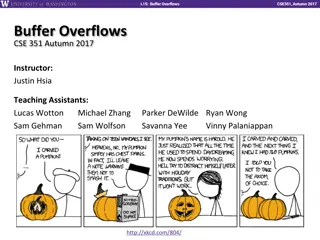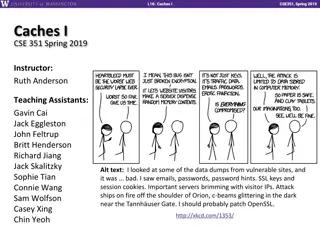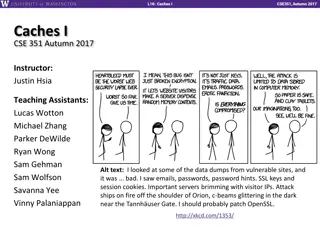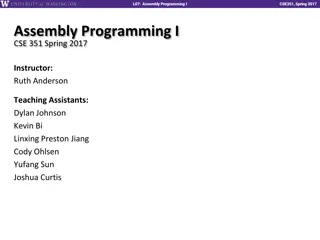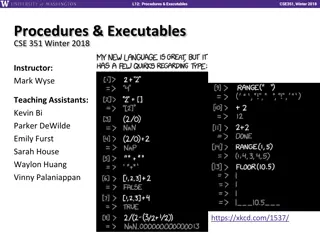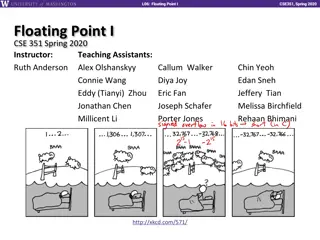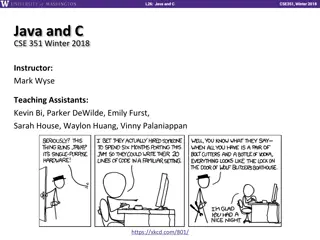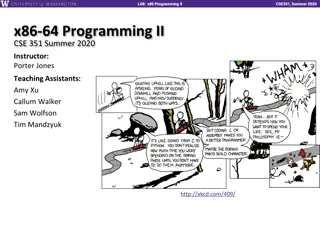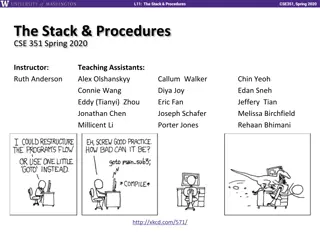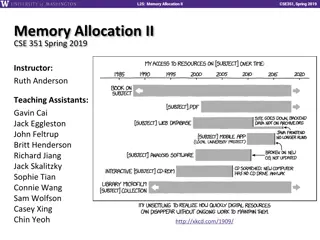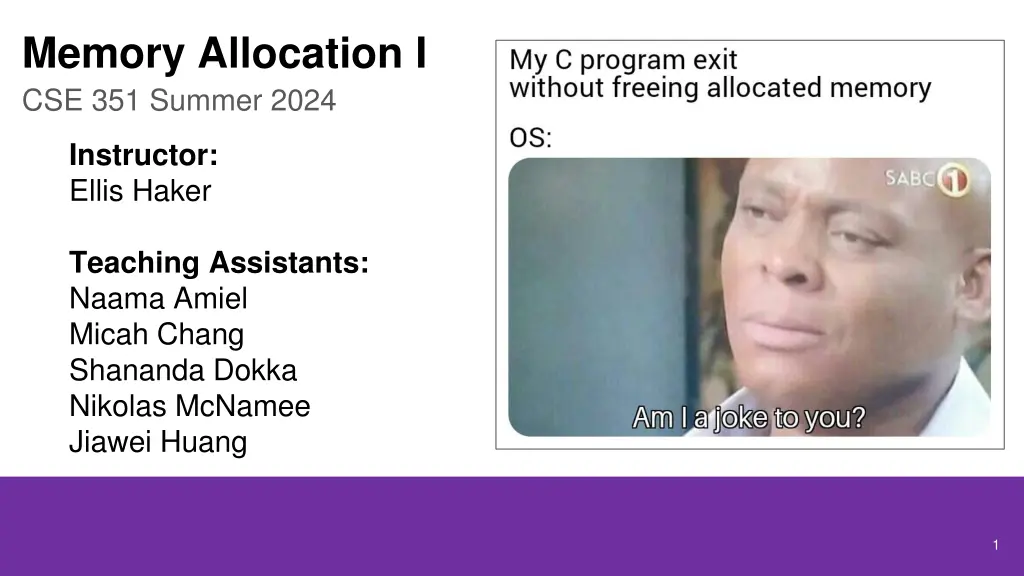
Dynamic Memory Allocation Overview
Dive into the world of dynamic memory allocation with an overview of malloc and free in C, common memory-related bugs, fragmentation, various allocation implementations, and the introduction to garbage collection. Understand how programs manage memory dynamically at runtime and explore the goals and processes involved in memory allocation and deallocation.
Download Presentation

Please find below an Image/Link to download the presentation.
The content on the website is provided AS IS for your information and personal use only. It may not be sold, licensed, or shared on other websites without obtaining consent from the author. If you encounter any issues during the download, it is possible that the publisher has removed the file from their server.
You are allowed to download the files provided on this website for personal or commercial use, subject to the condition that they are used lawfully. All files are the property of their respective owners.
The content on the website is provided AS IS for your information and personal use only. It may not be sold, licensed, or shared on other websites without obtaining consent from the author.
E N D
Presentation Transcript
Memory Allocation I CSE 351 Summer 2024 Instructor: Ellis Haker Teaching Assistants: Naama Amiel Micah Chang Shananda Dokka Nikolas McNamee Jiawei Huang 1
Administrivia Today Friday, 8/2 Monday, 8/5 RD21 due (1pm) HW19 due (11:59pm) HW17 due (11:59pm) RD20 due (1pm) No HW :) Lab 5 released (due 8/14) 2
Topic Group 3: Scale & Coherence How do we make memory accesses faster? How do programs manage large amounts of memory? How can we allocate memory dynamically (i.e. at runtime) How does your computer run multiple programs at once? 3
Dynamic Memory Allocation Overview Malloc and free in C Common memory-related bugs in C Fragmentation Explicit allocation implementation Implicit free lists Explicit free lists (Lab 5) Splitting and coalescing Implicit deallocation: garbage collection Introduction and goals Allocation and deallocation (free) 4
Multiple Ways to Store Program Data Static global data Fixed size at compile-time Lasts entire lifetime of the program Accessible anywhere in the program A portion is read-only (literals) Stack-allocated data Local/temporary variables Can be dynamically allocated (in some versions of C) Known lifetime (deallocated when function returns) Dynamic (heap) data Size and lifetime only known at runtime int array[1024]; void foo(int n) { int tmp; int local_array[n]; int* dyn = (int*)malloc(n*sizeof(int)); } 5
Dynamic Memory Allocation Programmers use dynamic memory allocators to acquire memory at runtime For data structures whose size or lifetime is known only at runtime Stored in heap segment of memory Types of allocators Implicit: language handles garbage collection, programmer only needs to allocate the data Ex: new in Java Explicit: programmer needs to allocate and deallocate memory Ex: malloc and free in C 6
Dynamic Memory Allocation (pt 2) Allocator organizes data into variable-sized blocks, which can be allocated or free What happens when the heap runs out of space? Allocator asks the OS for more! sbrk in Unix 7
Allocating Memory in C Need to #include <stdlib.h> void* malloc(size_t size) Allocates a contiguous block of size bytes of uninitialized memory size_t?! Simple typedef for an unsigned 8-byte integer Returns a pointer to the beginning of the allocated block Returns NULL if allocation failed, or size=0 Pointer to an invalid address (represented as address 0) Blocks typically aligned to 8 or 16 bytes Other versions: calloc: initializes memory to 0 realloc: moves existing block to a larger one 8
Freeing Memory in C void free(void* p) Releases block pointed to by p back to the pool of available memory Pointer p must be the address originally returned by malloc/calloc/realloc (i.e., beginning of the block) Don t call free on a block that has already been released! Undefined behavior - can even introduce buffer overflow vulnerabilities! No action occurs if you call free(NULL) 9
Best Practices for malloc and free malloc free Using sizeof makes code more portable (ints aren t 4B on all machines ) void* is implicitly cast, but explicitly casting will help you catch errors Ex: int* ptr = (int*) malloc(n * sizeof(int)); After calling free, set the pointer to NULL Avoids double-free errors Ex: free(ptr); ptr = NULL; 10
malloc and free Example void foo(int n) { int i, *p; p = (int*) malloc(n*sizeof(int)); // allocate space for array of n ints if (p == NULL) { // check for allocation error perror("malloc"); exit(0); } for (i=0; i<n; i++) p[i] = i; free(p); p = NULL; } // initialize int array // free p // good practice to set to NULL after free 11
malloc and free Interface Applications Must never access memory not currently allocated Must never free memory not currently allocated Must only use free with previously malloc ed blocks Allocators Must respond immediately to malloc Must allocate blocks from free memory Must align blocks so they satisfy all alignment requirements Can t move the allocated blocks 12
Heap Management in C Likely very different from what you re used to Programmer has to remember to free data when they re done with it Otherwise, causes a memory leak Requires keeping track of where your data is stored Bugs are common! 13
Find that Bug! int* p = (int*)malloc(N * sizeof(int)); for (int i = 0; i < N; i++) { *p = i; p++; } free(p); 14
Find that Bug! (pt 2) x = (int*)malloc(N * sizeof(int)); // manipulate x free(x); ... y = (int*)malloc(N * sizeof(int)); // manipulate y free(x); 15
Find that Bug! (pt 3) x = (int*)malloc(N * sizeof(int)); // manipulate x free(x); ... y = (int*)malloc(M * sizeof(int)); for (i=0; i<M; i++) { y[i] = x[i]++; } 16
Find that Bug! (pt 4) typedef struct L { int val; struct L* next; } list; // linked list node void main() { list* head = (list*) malloc(sizeof(list)); head->val = 0; head->next = NULL; // create and manipulate the rest of the list ... free(head); return; } 17
Dynamic Memory Allocation Overview Malloc and free in C Common memory-related bugs in C Fragmentation Explicit allocation implementation Implicit free lists Explicit free lists (Lab 5) Splitting and coalescing Implicit deallocation: garbage collection Introduction and goals Allocation and deallocation (free) 18
Notation We will draw memory divided into words Each word is 64 bit = 8 bytes Note: textbook and old videos still use 32-bit words Allocations will be aligned and in sizes that are a multiple of words 19
Performance Goals Given some sequence of malloc and free requests R0, R1, , Rk, , Rn-1, maximize throughput and peak memory utilization Often conflicting goals! 1) Throughput: Number of completed requests per some unit of time Example: If 5,000 malloc calls and 5,000 free calls completed in 10 seconds, then throughput is 1,000 operations/second 21
Performance Goals (pt 2) Aggregate Payload (Pk) malloc(p) returns a payload of p bytes After request Rkhas completed, Pk= the sum of currently allocated payloads Current Heap Size (Hk) Allocator can increase heap size using sbrk Assume allocator cannot decrease heap size 2) Peak Memory Utilization (Uk): Memory utilization = aggregate payload heap size i.e., how much of our heap contains payload data Uk= (maxi kPk) Hkafter k+1 requests i.e., the maximum utilization at any point up through when Rkhas completed 22
Fragmentation Recall fragmentation in structs Used to preserve alignment Internal: unused space inside of a struct (between fields) External: unused space between struct instances (after fields) The heap is similar Internal fragmentation: extra space inside an allocated block External fragmentation: extra space between allocated blocks 23
Internal Fragmentation Additional space inside of an allocated block not used to store a payload Causes Easy to measure, only depends on past requests Padding for alignment Overhead of maintaining heap data structures Explicit policy decisions (e.g., return a big block to satisfy a small request) 24
External Fragmentation Occurs when allocation/free pattern leaves holes between blocks Can cause situations where there is enough aggregate heap space to satisfy a request, but no single free block is large enough Don t know what future requests will be Difficult to impossible to predict if past placements will become problematic 25
Polling Question 1. Which of these statements is FALSE? A) Temporary arrays should not be allocated on the Heap B) malloc returns an address of a block that is filled with mystery data C) Peak memory utilization is a measure of both internal and external fragmentation D) An allocation failure will cause your program to stop 26
Dynamic Memory Allocation Overview Malloc and free in C Common memory-related bugs in C Fragmentation Explicit allocation implementation Implicit free lists Explicit free lists (Lab 5) Splitting and coalescing Implicit deallocation: garbage collection Introduction and goals Allocation and deallocation (free) 27
Implementation Issues How do we know how much memory to free given just a pointer? How do we keep track of the free blocks? How do we pick a block to use for allocation (when many might fit)? What do we do with the extra space when allocating a structure that is smaller than the free block it is placed in? How do we reclaim free blocks? 28
Knowing how much to free Store the length of the block in a header The word preceding the data Also may contain other info, like whether the block is allocated Requires an extra word for every block 29
Keeping track of free blocks Implicit Free List Use pointer arithmetic to traverse through entire heap until we find a free bock Explicit Free List Free block stores pointer to the next free block, forming a linked list Others not covered in this class Segregated free lists (different lists for each object type), sorting blocks by size 30
Implicit Free Lists For each block, we need to store: size, is_allocated Could use two works, but kinda wasteful Recap: if size is a multiple of 2n, then lowest n bits of the size are always 0 Use the lowest bit of header word to store is_allocated flag When reading size, mask this bit out a = 1 if allocated, 0 if free Block format: If the header value is h: h = size | a a = h & 1 size = h & ~1 size = total block size in bytes payload for allocated blocks only 31
Header Questions How many flags (boolean values) could we fit in our header if our allocator uses 16-byte alignment? If we placed a new flag in the second least significant bit, write out a C expression that will extract this new flag from the header! 32
Summary The heap is a segment of memory used to dynamically allocate data Useful when we don t know the size or when it can be freed until runtime Fragmentation is space in the heap that is not used to store payloads Internal: inside of a block External: between blocks C uses an explicit allocator, meaning the programmer decides when heap data is freed Different heap implementations Implicit free list: only store header and payload Explicit free list: free blocks store pointers to the next free block (next lecture) 33

